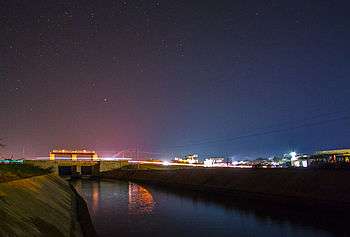Maski
| Maski | |
|---|---|
| village | |
 Maski Location in Karnataka, India | |
| Coordinates: 15°58′N 76°39′E / 15.96°N 76.65°ECoordinates: 15°58′N 76°39′E / 15.96°N 76.65°E | |
| Country |
|
| State | Karnataka |
| District | Raichur district |
| Languages | |
| • Official | Kannada |
| Time zone | IST (UTC+5:30) |
| PIN | 584124 |
| Vehicle registration | KA 36 |
| Website |
www |
Maski is a village and an archaeological site in the Lingasugur taluk of Raichur district of the state of Karnataka, India.[1] It lies on the bank of the Maski river which is a tributary of the Tungabhadra. Maski derives its name from Mahasangha or Masangi. The site came into prominence with the discovery of a minor rock edict of Emperor Ashoka by C. Beadon in 1915.[2] It was the first edict of Emperor Ashoka that contained the name Ashoka in it instead of the earlier edicts that referred him as Devanampiye piyadasi.[3][4] This edict was important to conclude that many edicts found earlier in the Indian sub-continent in the name of Devanampiye piyadasi, all belonged to Emperor Ashoka.[3] The edict is etched on a rock-face of Durgada-gudda, one of the gneissic outcrops that are present in the site.
Maski is also the place on the Raichur Doab which was also under the hegemony of the imperial Chola empire and it was here that Rajendra Chola I defeated Jayasimha II, the Western Chalukya ruler in battle in 1019-1020 AD.[5]
Excavation history

Maski was studied initially by Robert Bruce Foote in 1870 and 1888. In 1915, C. Beadon, a mining engineer, discovered Ashoka's rock edict here. In 1935-37, the archaeological department of Hyderabad state explored this region and in 1954, Amalananda Ghosh excavated this place on behalf of the Archaeological Survey of India.[1]
Findings
The excavations indicated that the region was occupied across four different cultural periods; Period I: Neolithic-Chalcolithic, Period II: Megalithic, Period III: Early historical and Period IV: Medieval. In Period I, microliths and blades made of agate, chert, carnelian and opal are found.[1] Ornamental beads of agate, coral, shell and other materials are also found. Dull-grey ware and painted-buff ware pottery are found, some of which were painted with linear patterns. Animal remains of cattle, buffalo, sheep and goat are also found.[1] Period II saw the introduction of iron and five different forms of burials were discovered. Lances, ferrules, daggers and arrowheads were found, apart from beads of gold and terracotta objects.[1] The pottery of Period II consisted of the megalithic red-and-black ware, all-black ware and red-slipped ware, some of which had graffiti on them. Coins were discovered in the Period III which also saw the use of Russet-coated painted ware. The earliest specimens of Indian glass were also discovered at Maski.[6] A cylinder seal has also been found here.[7]
Transport
Maski is well connected by road. It lies on Bangalore-Gulbarga road. Maski ia around 430 km from Bangalore, 80 km from raichur and 22 km from Sindhanur. Maski can be reached by KSRTC buses from all Major towns and cities in Karnataka. Raichur Junction, 80 km away, is the nearest railway station.
See also
References



| Wikimedia Commons has media related to Maski. |
- Ghosh, Amalananda (1990) [1990]. An Encyclopaedia of Indian Archaeology. BRILL. ISBN 90-04-09262-5.
- Smith, Vincent Arthur (1998) [1998]. Aśoka: The Buddhist Emperor of India. Asian Educational Services. ISBN 81-206-1303-1.
- Handa, O. C. (1994) [1994]. Buddhist Art and Antiquities of Himachal Pradesh. Indus Publishing. ISBN 81-85182-99-X.
- Dikshitar, Ramachandra V. R. (1993) [1993]. The Mauryan Polity. Motilal Banarsidass Publications. ISBN 81-208-1023-6.
- Raschke, Manfred G. (1978) [1978]. "New Studies in Roman Commerce with the East". In Hildegard Temporini, Wolfgang Haase. Aufstieg und Niedergang der römischen Welt. Geschichte und Kultur Roms. Walter de Gruyter. ISBN 3-11-007175-4.
- Caspers, During E. C. L. (1979) [1979]. "Statuary in the round from Dilmun". In Johanna Engelberta, Lohuizen-De Leeuw. South Asian Archaeology 1975: Papers from the Third International. BRILL. ISBN 90-04-05996-2.
